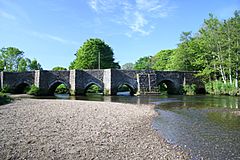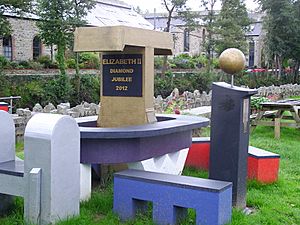Lostwithiel facts for kids
Quick facts for kids Lostwithiel
|
|
|---|---|
 The 12th-century bridge across the River Fowey |
|
| Lua error in Module:Location_map at line 530: Unable to find the specified location map definition: "Module:Location map/data/Cornwall (mainland)" does not exist. | |
| Population | 2,814 (2011) |
| OS grid reference | SX104598 |
| Civil parish |
|
| Unitary authority | |
| Ceremonial county | |
| Region | |
| Country | England |
| Sovereign state | United Kingdom |
| Post town | LOSTWITHIEL |
| Postcode district | PL22 |
| Dialling code | 01208 |
| Police | Devon and Cornwall |
| Fire | Cornwall |
| Ambulance | South Western |
| EU Parliament | South West England |
| UK Parliament |
|
Lostwithiel (pronounced "loss-WITH-ee-el") is a small town in Cornwall, England. It is located at the top of the estuary of the River Fowey. In 2011, about 2,899 people lived here. The name Lostwithiel comes from the Cornish language. It means "tail of a wooded area."
Contents
What Does the Name Lostwithiel Mean?
The meaning of the name Lostwithiel has been discussed for a long time. In the 1500s, some thought it came from an old Roman name, Uzella. This was translated as Les Uchel in Cornish.
Later, in the 1600s, people believed the name meant "tail of a lion." They thought the "lion" referred to a lord who lived in the nearby castle.
Today, most experts agree the name comes from the Old Cornish words Lost Gwydhyel. This means "tail-end of the woodland." If you look at the town from Restormel Castle, you can see why this name makes sense.
Lostwithiel's Past: A Brief History
Lostwithiel was started in the early 1100s. It was founded by Norman lords who built Restormel Castle nearby. The town received its official town charter in 1189. This meant it had special rights and freedoms.
In the late 1200s, Edmund, 2nd Earl of Cornwall, helped build important structures. These included the Stannary Palace, the town bridge, and the square church tower.
Lostwithiel During the English Civil War
A major event in Lostwithiel's history was the Battle of Lostwithiel. This battle happened in 1644 during the First English Civil War. In this fight, the Parliamentarian forces, called Roundheads, were defeated by the Royalists. Even though the Parliamentarians eventually won the war, Cornwall remained under Royalist control until 1646.
Changes in Political Power
Lostwithiel used to elect two members to the Unreformed House of Commons. This was a part of the British Parliament. However, in 1832, a law called the Reform Act 1832 changed this. Lostwithiel lost its right to elect members to Parliament.
The town was a municipal borough until the 1960s. Then, it became a civil parish. The town's old seal showed a castle rising from water. It also had two thistles and two fish. The mayor's special items include a silver oar. This shows that Lostwithiel once had control over the River Fowey.
Where is Lostwithiel Located?
Lostwithiel is in the valley of the River Fowey. It sits between the A390 road and the upper part of the river that is affected by tides.
Lostwithiel's Transport Links
Lostwithiel railway station is on the Cornish Main Line. This line connects Plymouth to Penzance. The station is on the south side of town, just over the old medieval bridge. The railway workshops, built for the Cornwall Railway, were once here. In 2004, these buildings were turned into apartments.
A special branch line from Lostwithiel takes trains carrying china clay to Fowey.
Parts of the Town
The town has different areas. Bridgend is to the east. Rosehill and Victoria are to the west of the River Fowey.
To the south of Lostwithiel is the Shirehall Moor nature reserve. This reserve follows the River Fowey. It opens up into a large salt marsh. The reserve is a great place for birds. You can see swans, ducks, egrets, herons, kingfishers, and Canada geese there.
Important Buildings in Lostwithiel
Lostwithiel has several interesting buildings. The most famous are St Bartholomew's Church and Restormel Castle. The town was once a very important "stannary" town. This meant it was a center for tin mining.
There is a beautiful bridge from the early 1300s with six pointed arches. Nearby are the remains of the Stannary Palace. This building has an old exchequer hall. The Lostwithiel Guildhall on Fore Street has arches on the ground floor. It also houses the local museum.
Culture and Events in Lostwithiel
Lostwithiel has a playing field called King George V Playing Field. There are also several large parks, like Coulson Park. This park was named after Nathaniel Coulson. He was a rich businessman who grew up in Lostwithiel.
The town hosts many fun events each year. These include an arts and crafts festival and a beer festival. There is also a week-long carnival in the summer. In October, you can enjoy food and cider festivals. In December, the town has a special Dickensian evening.
Sports in Lostwithiel
Cornish wrestling competitions have been held in Lostwithiel for hundreds of years. These events took place at various locations, including Coulson Park.
In 1982, Lostwithiel was the host for the Interceltic Games. This event celebrates the cultures and sports of Celtic nations.
Education in Lostwithiel
Lostwithiel has two primary schools: St Winnow C E School and Lostwithiel Primary School. Both schools are now "academies." This means they are run independently from the local council.
Most children aged 11 to 16 go to Fowey River Academy or Bodmin College.
The Lostwithiel Educational Trust is a local charity. It gives money to schools and churches. It also helps individuals for educational purposes.
Getting Around Lostwithiel
Trains stop at Lostwithiel railway station about once or twice an hour. You can travel to Plymouth or Penzance. Many trains also go further to Cardiff Central or London Paddington.
National Express offers a regular bus service to London. This coach stops outside the Royal Talbot Hotel.
Other bus stops in Lostwithiel are also near the Royal Talbot Hotel and by the Cott Road phone box.
Town Twinning
Lostwithiel has a special friendship with a town in France. Since 1979, it has been twinned with Pleyber-Christ in Brittany. People from the Twinning Associations in both towns usually meet every year. They take turns visiting each other's towns.
Images for kids
See also
 In Spanish: Lostwithiel para niños
In Spanish: Lostwithiel para niños








